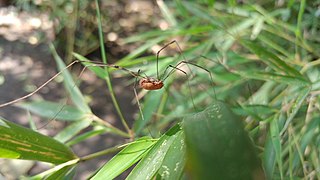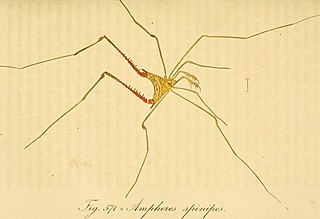
Misumenoides is a genus of spiders in the family Thomisidae. Spiders in this family are commonly called "crab" or "flower" spiders.

Metaphidippus is a genus of jumping spiders that was first described by Frederick Octavius Pickard-Cambridge in 1901. The name is combined from Ancient Greek μετά "after, beside" and the salticid genus Phidippus.

Castianeira is a genus of ant-like corinnid sac spiders first described by Eugen von Keyserling in 1879. They are found in Eurasia, Africa, and the Americas, but are absent from Australia. Twenty-six species are native to North America, and at least twice as many are native to Mexico and Central America.

Lycosa is a genus of wolf spiders distributed throughout most of the world. Sometimes called the "true tarantula", though not closely related to the spiders most commonly called tarantulas today, Lycosa spp. can be distinguished from common wolf spiders by their relatively large size. This genus includes the European Lycosa tarantula, which was once associated with tarantism, a dubious affliction whose symptoms included shaking, cold sweats, and a high fever, asserted to be curable only by the traditional tarantella dance. No scientific substantiation of that myth is known; the venom of Lycosa spiders is generally not harmful.

Pachylinae is the most diverse subfamily of the harvestman family Gonyleptidae, including around 400 valid species. Major groups of species occur in the Brazilian Atlantic forest, Bolivian/Peruvian highlands, Argentina and Chilean temperate forest.

The Sclerosomatidae are a family of harvestmen with about 1,300 known species. One former subfamily has been recently removed to form a new family, Globipedidae.
The Stygnidae are a family of neotropical harvestmen within the suborder Laniatores.
Agoristenidae are a neotropical harvestman family of the Suborder Laniatores, in the superfamily Gonyleptoidea.
The Manaosbiidae are a family of neotropical harvestmen within the suborder Laniatores.
Kimulidae is a small neotropical family of the harvestman infraorder Grassatores with about thirty described species.
Paratamboicus was a genus of harvestmen in the family Sclerosomatidae from the Americas, described by Mello-Leitão 1940 with the type-species by original designation being Paratamboicus bicornutus Mello-Leitão, 1940. It was much later considered as Junior subjective synonym of Holcobunus Roewer 1910 by Tourinho & Kury (2001).

Prionostemma is a large genus of harvestmen in the family Sclerosomatidae from Mexico, Central America, and South America.
Caelopyginae is a harvestmen sub-family in the family Gonyleptidae, containing the following genera:

Geolycosa is a genus of wolf spiders first described in 1904.

Mummuciidae is a family of solifuges, first described by Carl Friedrich Roewer in 1934.

Ampheres is a genus of neotropical harvestmen
Discosomaticinae is a subfamily of harvestmen in the family Cosmetidae.
Holcobunus is a genus of the order Opiliones in the family Sclerosomatidae. The genus was first described by Roewer, 1910









